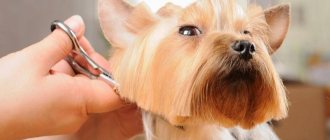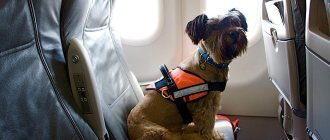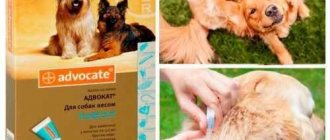When you buy a puppy from a breeder or adopt from a shelter, one of many or the only document will be a dog passport. Information about deworming (tablets or drops for worms) and vaccination is pasted into the main part. On the first spread, the pet's name is written, sometimes there is space for a photo, and the remaining fields are divided into several columns: there are places for pasting a vaccine sticker, transcript, date and doctor's signature.
Why do you need a veterinary passport?
A veterinary passport is important for the life, health and movements of your pet. Without this document many things are impossible. The certificate itself can be of Russian or international standard.
Internal veterinary passport
The internal veterinary passport in Russia performs important functions. In its absence:
- the dog will not be allowed on the train or plane;
- if you decide to travel without a pet, most foster homes will refuse due to lack of information about vaccinations;
- an animal with a pedigree will not be able to take part in exhibitions and breeding;
- if necessary, it will be more difficult to prove your ownership of the pet;
- If a dog bites someone, the victim will have to undergo a complex course of anti-rabies treatment, unless there is information about rabies vaccination.
For travel you will also need a certificate from a veterinarian in Form No. 1. It must be issued immediately before the trip, because it is only valid for five days.
International passport
An international certificate is required if you are taking your pet abroad. For other countries, all information must be duplicated in English. Filling out is most often done by a veterinarian, and in front of the vaccinations you need to put stamps.
On the first spread, as in the internal certificate, data about the pet is filled out, the number of the brand, pedigree is indicated, and if there is a chip, then a barcode is pasted in that matches the information about chipping.
Since other countries may have different vaccination dates and additional vaccinations, it is better to make sure that all documentation is in order so as not to turn around at the border.
Help for cats types
| Photo | Name | Purpose | Requirements | Validity | Who issues | Comments |
| (sheet A4 on both sides) | Veterinary certificate (form No. 1) | to move a cat outside of one city (district), including abroad | Veterinary passport with all correctly completed marks Rabies vaccination (no earlier than 11 months, but no later than 30 days before travel; for revaccination: no later than 14 days), only for animals older than 2 months Vaccinations against rhinotracheitis, panleukopenia and calcivirosis (no earlier than 11 months, but no later than 14 days before the trip) Luminescent testing for microsporia (lichen) Treatment for parasites (or testing for their presence) (maximum 3 months before travel) Microchip or stamp Visual inspection of the cat* | 5 days before the start of transportation and throughout the entire period of transportation, until the end of movement to the destination | Head/doctor of a state veterinary institution | In addition to these requirements, it is also necessary to comply with the requirements of the country of import For countries and Georgia, the certificate is certified by the PVKP stamp** |
(two A5 sheets, spine and certificate) (the spine remains with the doctor) | Veterinary certificate of the Customs Union (form No. 1) | To move a cat within a vehicle | -//- | -//- | The spine is identical to the certificate, the only difference is the signature of the certificate recipient | |
(two A5 sheets, spine and certificate) (the spine remains with the doctor) | Veterinary certificate (form No. 4) | To move a cat within one area (city) | -//- | Veterinarian/paramedic of state veterinary institution | -//- | |
(sheet A3 on both sides) | Veterinary certificate (form No. 5a) | To move a cat outside the Customs Union, CIS and Georgia | Veterinary passport with all correctly completed marks Veterinary certificate (form No. 1) Microchip or stamp Visual inspection of the cat + owner’s international passport and tickets (if you are not traveling by car) | -//- | Rosselkhoznadzor official at PVKP | You can bring a cat back to Russia using the same certificate, if no more than 90 days have passed since the date of its receipt and if there has been no outbreak of diseases in the country of export (confirmed by the local veterinary service 24 hours before departure) |
| Veterinary certificate (form No. 6.1) | To move a cat imported from abroad within the Russian Federation | Veterinary documents of the country of export Requirements for the import of animals into the territory of the Russian Federation | -//- | -//- | Necessary for a cat whose certificate No. 5a has expired or which is being imported into Russia for the first time, if its movement does not end at the border crossing point of the Russian Federation and its immediate environs | |
| see here | EU veterinary certificate (European certificate) | To move a cat into the country | Is an attachment to form No. 5a | 10 days before crossing the EU border; 4 months to travel within the EU | -//- (you can fill it out yourself and only have it certified by the PVKP) | A European certificate is required not only for EU countries, but also for some other European countries (Switzerland, Norway) The EU veterinary certificate must be completed in English and its fields must be written in English and in the language of the country of import |
| – | Export permit from Rosselkhoznadzor | To move more than 2 cats outside the Russian Federation | – | – | Department of Veterinary Medicine for a constituent entity of the Russian Federation |
*These are the maximum possible requirements (St. Petersburg), as a rule, in most regions of Russia only a valid rabies vaccination and a veterinary passport with information about it are required, and everything else is done “with words”. As for treatment against parasites, they usually only require treatment for worms; it is either carried out upon receipt of a certificate (they give a tablet), or in advance (5-7 days before receiving the certificate) a stool test is taken for worms.
**PVKP – Border Veterinary Control Point; list of items can be found here
All veterinary documents can be completed at the place of actual residence (not by registration!)
How and where to get a veterinary passport
Respectable nurseries start selling puppies no earlier than one and a half to two months. By the minimum age of sale they already have the first vaccinations. Therefore, when purchasing a purebred dog from a kennel, the owner does not need to think about how to get a veterinary passport for the dog - it already exists and is even partially filled out. The new owner receives a set of papers: a puppy card, which must be exchanged for a pedigree within six months, a purchase and sale agreement and a veterinary passport with the first deworming and vaccinations. The latter is also issued if you adopt an animal from a shelter.
How to get a passport for a dog if it was picked up on the street? Forms are sold in pet stores, but without marks - it's just paper. The easiest way is to purchase it at the veterinary clinic when you come to vaccinate your pet. The pet is vaccinated and immediately signed with a stamp.
The price of the form varies from 50 to 100 rubles, often it is already included in the cost of vaccination.
Obtaining a veterinary certificate at Pulkovo Airport
My advice is to call the veterinary control service at the airport in advance and, if you have time and opportunity, issue a certificate in advance. I try to do this 2 days before departure, since I try to buy tickets for early morning flights (so that the dog sleeps during the flight and gets his night's sleep). But also, by filling out a certificate directly before the plane, you will never guess whether there is a queue at the veterinary service, and according to the employees and our personal experience, certificates are issued for someone all the time. If you don’t want to wait and be nervous before departure, then just arrive early. In St. Petersburg, we receive an international certificate in the new terminal of Pulkovo Airport. There is a very good map on the airport website, where everything is clear where to go, but nevertheless, at the entrance you can ask the employees. It's hard to get lost. The Pulkovo Veterinary Service is located in the arrivals building on the first floor!!! (Why the arrival? It’s just that they still check bags with lard and sausage more often than they check out the animals, really). After the security check at the entrance, turn right and then straight all the way to the garbage sorting boxes and large letters Departure and then to the left and follow the arrows printed on A4 pieces of paper to get where you need to go))
The veterinary control telephone number at Pulkovo Airport is 8-923-418-56-29. Veterinary certificates are issued around the clock, but it’s still worth calling and checking. Lunch from 13-30 to 14-00. One day we arrived to pick up a certificate at 4 am and simply called the phone number on the door and woke up the employee.
What information is included in a dog’s veterinary passport?
The passport contains as much information as possible about the animal and its owner. Part of the column is filled in by the owner, part by the veterinarian at the clinic.
Owner details
On the first page, in addition to general information, information about the owner is usually indicated: full name, age, residential address, telephone number. This is necessary to confirm ownership of the dog, as well as in cases where the pet escapes.
Dog information
Enter the following information regarding your furry friend:
- nickname in full, as in the metric (if there is one);
- floor;
- date of birth (if a foundling, then approximate);
- breed;
- coat color and type;
- number and location of the mark;
- after receiving the pedigree - its number;
- chip data.
If desired, you can indicate special features of your pet - information about sterilization, chronic diseases, eye color, etc.
Information about vaccination and deworming
In this section, a record of the vaccination is not simply entered, but a sticker is pasted with the name of the drug, its series and number, after which all data is certified by the seal and signature of the doctor who performed the procedure.
The owner can paste stickers from anthelmintic tablets on his own, as well as write down when flea and tick treatment was carried out. If information about deworming is needed for travel, then it is also certified by a veterinarian.
Information about matings
Separate documentation is drawn up for planned matings, but if you wish, you can fill out information about the matings: the date of the main and control matings, the name of the partner, the duration of pregnancy, the date of birth and the number of puppies. The veterinarian can enter some details about the birth, such as caesarean section, duration, complications, etc.
How to fill out a passport form correctly
If you are drawing up a certificate for yourself, the filling technique does not matter. But at customs or when issuing plane or train tickets, government officials may find fault with illegible handwriting, so it is better to fill out all lines in block letters using a black pen. You can ask for a sample form at the veterinary clinic or look it up on the Internet. The numbers of all documents and data must match and be recorded without errors. The certificate must not contain torn pages - in this case it is considered invalid. To travel abroad, everything must be filled out or duplicated in English, the nickname must be in Latin.
Vet control at Finlyandsky station
Despite the fact that veterinary control is supposedly located at the Finland Station, the territory of this very station is huge and the address Botkinskaya Street does not mean anything. If you are facing the entrance to the station, then go around it to the left until you run into a bunch of police bobbies.
You reach this building and go right through the iron black door.
In winter we had to wait a very long time. But the winter period of the New Year holidays is generally the hottest time for issuing certificates for those who cross the border by car. But in the summer there were no people.
What to do if your passport is lost
Anything can get lost in life, and your veterinary passport is no exception. The owners put it somewhere and cannot find it, lost it or forgot it at an exhibition, on a trip, etc. This is especially easy to do when there are several animals. If the search is unsuccessful, the document will have to be restored.
This may scare the owner, but in reality there is nothing wrong with it. To recover, the owner should contact the veterinary clinic where the animal was last vaccinated. It is very convenient if the dog has been seen by one doctor since birth - in this case, in addition to the last vaccination, all the data will be written down. Of course, vaccine stickers will not be pasted into the box, but simply written by hand, but together with the doctor’s signature and the clinic’s seal, this will be an equivalent replacement. If the animal was served by different clinics, then the latter will provide you with the latest information, which is usually what you need.
When a visitor comes to the clinic, his data is entered into a journal, and now into a computer, even if it is just an examination. These measures allow:
- Store information about the patient’s treatment and prevention, which can help with future visits.
- Keep records of customer visits.
- Remind forgetful owners that the next revaccination date is approaching.
- Provide activity reports to inspection organizations.
- Maintain accounting.
All data is stored for ten years, that is, almost the entire life of the animal.
It is much easier to restore documents if the pet has been microchipped. After the microchipping procedure, the veterinary clinic doctor enters the pet’s chip identification number into a unified database (UDB). Subsequently, after any procedure, in particular vaccinations, the chip information is updated and new information is added there. Thus, the loss can be restored using data from the chip database. There is only one minus - if you come across an unscrupulous specialist who did not update the data, it will not be in the database.
When receiving any records from a veterinary clinic with which you plan to travel around the country or abroad, you need to carefully check all completed lines with the documents to eliminate errors.
Restoring a veterinary passport is free, the only thing you have to pay for is the document form.
Chip or tattoo
For transportation of an animal both within the country and for export abroad, a mandatory document is a certificate in Form No. 1, the basis for which is the presence of identifiers on the animal’s body.
Whether your dog (cat) should be microchipped or whether one tattoo will be enough to receive this certificate is decided based on where you plan to go. Each country has its own requirements. There is a common expression on the Internet that a microchip is the size of a grain of rice. Which sounds like it's so small. Now look at this syringe that is used to insert a microchip into the withers of your dog or cat. Or pick up a grain of rice and imagine how thick the needle will be. Well, to understand. We received a microchip at the age of 3 months along with a vaccination against rabies and a second one against distemper. The dog survived the installation of the chip well, only the veterinarian was unable to pierce him the first time and then he was very afraid, so we had to wait and calm him down.











